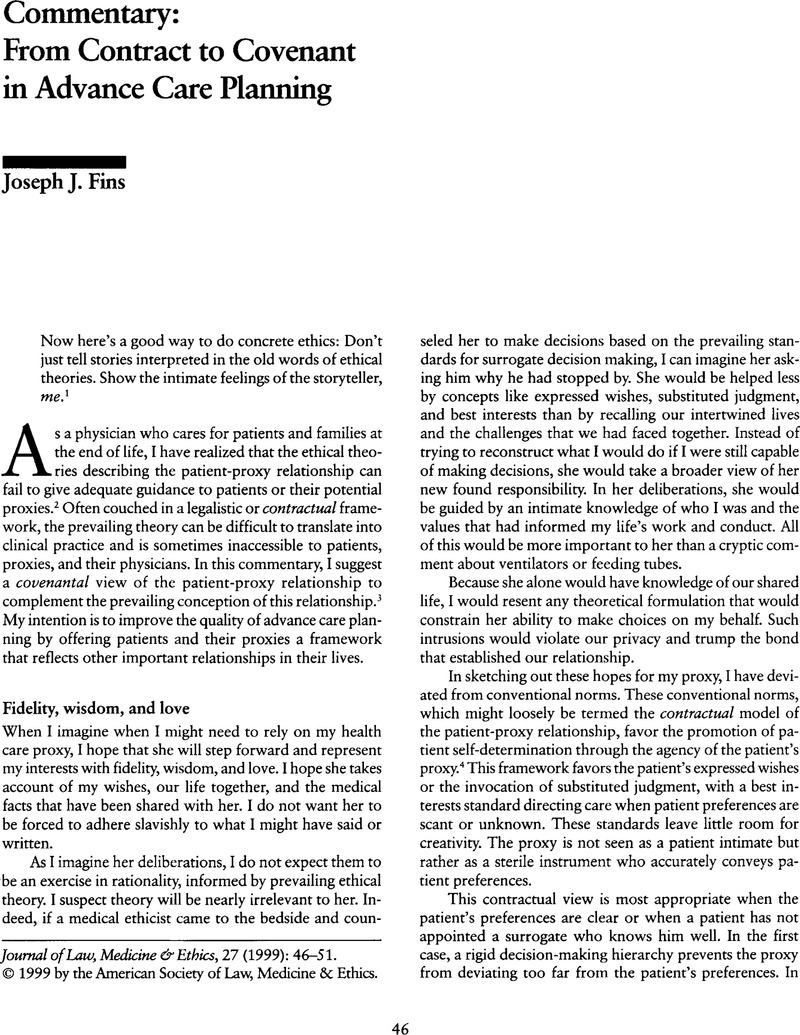Crossref Citations
This article has been cited by the following publications. This list is generated based on data provided by Crossref.
Doukas, David J.
and
Hardwig, John
2003.
Using the Family Covenant in Planning End‐of‐Life Care: Obligations and Promises of Patients, Families, and Physicians.
Journal of the American Geriatrics Society,
Vol. 51,
Issue. 8,
p.
1155.
Maltby, Barbara S.
and
Fins, Joseph J.
2004.
Informing the Patient-Proxy Covenant: An Educational Approach for Advance Care Planning.
Journal of Palliative Medicine,
Vol. 7,
Issue. 2,
p.
351.
Karel, Michele J.
Powell, Jean
and
Cantor, Michael D.
2004.
Using a Values Discussion Guide to facilitate communication in advance care planning.
Patient Education and Counseling,
Vol. 55,
Issue. 1,
p.
22.
Romer, Anna L.
and
Hammes, Bernard J.
2004.
Communication, Trust, and Making Choices: Advance Care Planning Four Years On.
Journal of Palliative Medicine,
Vol. 7,
Issue. 2,
p.
335.
Briggs, Linda
2004.
Shifting the Focus of Advance Care Planning: Using an In-depth Interview to Build and Strengthen Relationships.
Journal of Palliative Medicine,
Vol. 7,
Issue. 2,
p.
341.
Schwartz, Carolyn E.
Merriman, Melanie P.
Reed, George W.
and
Hammes, Bernard J.
2004.
Measuring Patient Treatment Preferences in End-of-Life Care Research: Applications for Advance Care Planning Interventions and Response Shift Research.
Journal of Palliative Medicine,
Vol. 7,
Issue. 2,
p.
233.
Fins, Joseph J.
2005.
The Boundaries of Consciousness: Neurobiology and Neuropathology.
Vol. 150,
Issue. ,
p.
565.
Werth, James L.
2005.
Becky's Legacy: Personal and Professional Reflections on Loss and Hope.
Death Studies,
Vol. 29,
Issue. 8,
p.
687.
Fins, Joseph J.
Maltby, Barbara S.
Friedmann, Erika
Greene, Michele G.
Norris, Kaye
Adelman, Ronald
and
Byock, Ira
2005.
Contracts, covenants and advance care planning: an empirical study of the moral obligations of patient and proxy.
Journal of Pain and Symptom Management,
Vol. 29,
Issue. 1,
p.
55.
Fins, Joseph J.
2009.
The Neurology of Consciousness.
p.
234.
Hossler, Carrie
Levi, Benjamin H.
Simmons, Zachary
and
Green, Michael J.
2011.
Advance care planning for patients with ALS: Feasibility of an interactive computer program.
Amyotrophic Lateral Sclerosis,
Vol. 12,
Issue. 3,
p.
172.
Penn, A A
Paris, J J
and
Moore, M P
2013.
Decision making for seriously compromised newborns: the importance of exploring cultural differences and unintended consequences.
Journal of Perinatology,
Vol. 33,
Issue. 7,
p.
505.
Fins, Joseph J.
2016.
The Neurology of Conciousness.
p.
241.
Fins, Joseph J.
2017.
Debates About Neuroethics.
p.
45.
Meltzer, Ellen C.
Shi, Zhenzhen
Suppes, Alexandra
Hersh, Jennifer E.
Orlander, Jay D.
Calhoun, Aaron W.
Tung, Judy
Logio, Lia
Manna, Ruth
Bialer, Philip A.
Acres, Cathleen A.
and
Fins, Joseph J.
2017.
Improving Communication With Surrogate Decision-Makers: A Pilot Initiative.
Journal of Graduate Medical Education,
Vol. 9,
Issue. 4,
p.
461.
2018.
Approach to the Psychiatric Patient: Case-Based Essays, Second Edition.
p.
473.



